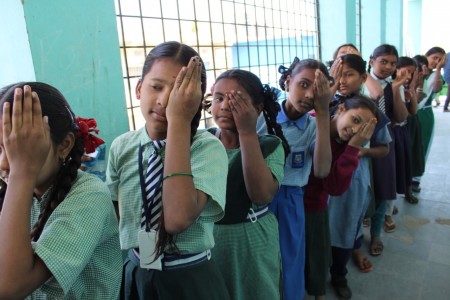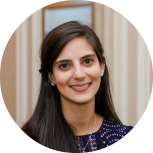
Girls wait to have their vision screened in Hyderabad, India
Credit: Dr Priya Morjaria
By Dr Priya Morjaria
Gender has consequences for health, and eye health is no exception. A person’s gender impacts their exposure to health risks and health-seeking behaviour. It can also affect their experience in a health facility – whether they can access it, afford treatment and even the conversations they can have with a healthcare provider. While there has been a lot of progress in recent decades towards gender equity in eye health care, we still have a long way to go.
Mariam’s story
I met Mariam when she was nearly 13 years old, although she looked about 10. I was leading a trial to test an early version of the Peek school eye health system in Hyderabad, India for my PhD. As a practising optometrist, I have often seen children with impaired vision but I remember Mariam very clearly – she was barely able to see a few metres ahead of her. I tested her vision and, as I expected, she was severely short-sighted in both eyes. We helped her choose some frames and showed her what her corrected vision would look like. I’ll never forget her expression as she looked through the trial frames – her smile was a mixture of pure joy and shock. She picked some pink frames and was so excited to take them home.
Part of the study was to understand how many children were wearing their spectacles three months later. I remembered Mariam’s school and when we were doing the follow-up school visits I was looking forward to seeing her and finding out whether she was still wearing her pink frames that she had picked so enthusiastically. We had a pre-populated list of all the children to check and when we finished going through it, there were some children who were absent. Looking through the absentees I recognised Mariam’s name. I asked the teacher about her and she ran back to her classroom, returning with a dusty spectacle case labelled ‘Mariam’.
She handed me the case and explained that Mariam was not at school. “That’s fine,” I told her, “She can still keep the spectacles, we haven’t come to take them back”. She shook her head and told me, “No, Mariam is no longer at school”. With help from the field team who spoke the local language, the teacher explained that Mariam had not been at school for nearly four months. She had maybe used her new pink spectacles for a week or two at school before being removed from school as it was ‘time to get married’. I never saw Mariam again but years on, I still think of her smile when she looked through the trial frame.
Making gender equity in eye health visible
Gender inequity is complex and cannot be solved easily. But those of us working in eye health can be part of the solution by recognising the importance of planning programmes that recognise gender inequality and have mechanisms available to address it.
With Peek Solutions, eye health services can track data from their programmes in real time. For example, we can track a patient journey from the moment they are identified as having a vision problem to receiving care, whether at primary, secondary or tertiary level. Data can be broken down by gender, which allows programmes to understand who is accessing a health service, for which conditions and whether patients are receiving treatment. Many health services collect this data, but it is not usually reported by gender, nor can it be tracked across different levels of care.
Of course, getting good data on how eye health services are being used is just the first step. With the help of Peek, our partners are getting new insights into who is accessing their services, which allows them to develop specific local solutions when they identify inequities.
For example, in the CBM-Peek community eye health initiative led by the College of Ophthalmology and Vision Science (COAVS) in Pakistan, three months after the programme started the data revealed that more women than men were accessing the services. We were all curious to understand why this was happening as we had assumed it would be the other way around with fewer women accessing eye health services. It transpired that men weren’t accessing the services because Lady Health Workers were conducting the screening; people assumed that the service was only for women. Once the programme team understood this, they targeted their advocacy to ensure that the men also accessed the eye health screening and referral service. The proportion of men accessing the service rose rapidly thereby establishing gender equity in the programme.
Addressing gender inequity wherever we see it
With Peek, eye health service providers are accessing data to improve the equity of their services. Unlike our example in Pakistan, research suggests that women are less likely to access eye health services in the majority of low- and middle-income countries. My own experience has taught me some invaluable lessons on how difficult it can be for a female growing up wearing spectacles – where you can be seen as being of less value to society or be reminded that if you wear spectacles you won’t be able to get married.
I still have the pink pair of spectacles that were meant for Mariam and they serve as a reminder to me of missed opportunities. It is important to recognise that gender equity manifests in different ways depending on the culture and the society. There are many reasons why women are less likely to access eye health services globally. Many of these reasons are complex, societal issues, but in eye health specifically, I believe it is critical to address gender inequity wherever we see it.
About the author

Dr Priya Morjaria is Head of Global Programme Design at Peek Vision and Assistant Professor of International Eye Health at the International Centre for Eye Health (ICEH), London School of Hygiene & Tropical Medicine (LSHTM). She practiced community and hospital optometry for several years, before joining the ICEH at LSHTM to pursue her interest in public health full-time. She has over 12 years of experience in the field of public health and is a trained optometrist who is now at the forefront of public health optometry.